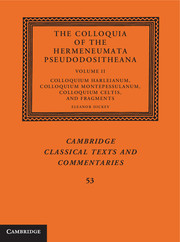Book contents
- Frontmatter
- Dedication
- Content
- List of plates page
- List of figures
- Acknowledgments
- Part One Colloquium Harleianum
- 1 Introduction to the Colloquium Harleianum
- TEXT, TRANSLATION, AND CRITICAL APPARATUS
- 2 Index Siglorum
- 3 Colloquium Harleianum
- Commentary
- 4 Commentary
- Part Two Colloquium Montepessulanum
- 5 Introduction to the Colloquium Montepessulanum
- Text, Translation, and Critical Apparatus
- 6 Index Siglorum
- 7 Colloquium Montepessulanum
- Commentary
- 8 Commentary
- Part Three Colloquium Celtis
- 9 Introduction to the Colloquium Celtis
- Text, Translation, and Critical Apparatus
- 10 Index Siglorum
- 11 Colloquium Celtis
- Commentary
- 12 Commentary
- Part Four Related texts
- 13 Editions of Papyri Connected to the Colloquium Tradition
- 14 The Berlin Trilingual Papyrus (P.Berol. INV. 10582): Reprinted Edition
- 15 Assorted Conversational Fragments(P.Berol. INV. 21860): New Edition
- 16 A Glossary Including Conversational Phrases (P.Lond. II.481): New Edition
- 17 A Glossary of Homonyms with Grammatical Information (P.Sorb. INV. 2069 Verso): Reprinted Edition
- 18 Grammatical Paradigms for Latin Learners (P.Louvre INV. E 7332): Reprinted Edition
- Endmatter
- References
- Indices to volumes I and II
- Index of notable Greek words and phrases
- Index of notable Latin words and phrases
- Index of topics mentioned in the colloquia
- Index of subjects discussed in the introduction and commentary
5 - Introduction to the Colloquium Montepessulanum
Published online by Cambridge University Press: 25 November 2020
- Frontmatter
- Dedication
- Content
- List of plates page
- List of figures
- Acknowledgments
- Part One Colloquium Harleianum
- 1 Introduction to the Colloquium Harleianum
- TEXT, TRANSLATION, AND CRITICAL APPARATUS
- 2 Index Siglorum
- 3 Colloquium Harleianum
- Commentary
- 4 Commentary
- Part Two Colloquium Montepessulanum
- 5 Introduction to the Colloquium Montepessulanum
- Text, Translation, and Critical Apparatus
- 6 Index Siglorum
- 7 Colloquium Montepessulanum
- Commentary
- 8 Commentary
- Part Three Colloquium Celtis
- 9 Introduction to the Colloquium Celtis
- Text, Translation, and Critical Apparatus
- 10 Index Siglorum
- 11 Colloquium Celtis
- Commentary
- 12 Commentary
- Part Four Related texts
- 13 Editions of Papyri Connected to the Colloquium Tradition
- 14 The Berlin Trilingual Papyrus (P.Berol. INV. 10582): Reprinted Edition
- 15 Assorted Conversational Fragments(P.Berol. INV. 21860): New Edition
- 16 A Glossary Including Conversational Phrases (P.Lond. II.481): New Edition
- 17 A Glossary of Homonyms with Grammatical Information (P.Sorb. INV. 2069 Verso): Reprinted Edition
- 18 Grammatical Paradigms for Latin Learners (P.Louvre INV. E 7332): Reprinted Edition
- Endmatter
- References
- Indices to volumes I and II
- Index of notable Greek words and phrases
- Index of notable Latin words and phrases
- Index of topics mentioned in the colloquia
- Index of subjects discussed in the introduction and commentary
Summary
SOURCES FOR THE TEXT
The basic manuscript tradition of the colloquium Montepessulanum is simple, as the text is found in only one manuscript, but extracts also occur in a glossary that is preserved in a much more complicated fashion. There is also a papyrus containing material related to the colloquium.
THE MONTPELLIER MANUSCRIPT
The colloquium Montepessulanum is named after the only manuscript to preserve it intact, H 306 in the Bibliothèque universitaire de médecine at the Université Montpellier 1 (Mp). This manuscript, produced in France in the second quarter of the ninth century (Bischoff 1998–2004: II.206), contains a large and diverse group of texts, including several glossaries and the Hermeneumata Montepessulana. These Hermeneumata consist of the colloquium, a long capitula section, and a short alphabetical glossary that seems to come from a different source; the colloquium is found at the start of the Hermeneumata section, on folios 139r–146v.
The text is written in a clear, careful hand, laid out with two columns per page and generous spacing. The Greek is in capitals and the Latin in minuscule; the Latin (the right-hand column) was written first and then the Greek (the left-hand column), but the copyist exercised great care to avoid the misalignment that so easily results from such a copying system. He appears to have checked the alignment with almost every Greek word he wrote, for a significant number of lines that had been omitted in copying the Latin (a problem that would normally lead to misalignment when the two columns were copied separately) were added at this stage. After both columns were complete someone – perhaps the original copyist but more likely another from the same time and place – compared the text to its exemplar and made some additional corrections, including indications (using Tironian notes) when the absence of material was due to gaps already present in the original.
In the Greek of the colloquium and the capitula many words have been divided using raised dots, some of which seem to have been written along with the letters themselves and others added subsequently. Goetz believed (1892a: xxvi) that all the dots were later (though still ninth-century) additions by the person who added the Tironian notes, but he failed to observe that there are two distinct types of dots.
- Type
- Chapter
- Information
- The Colloquia of the Hermeneumata Pseudodositheana , pp. 83 - 92Publisher: Cambridge University PressPrint publication year: 2015



